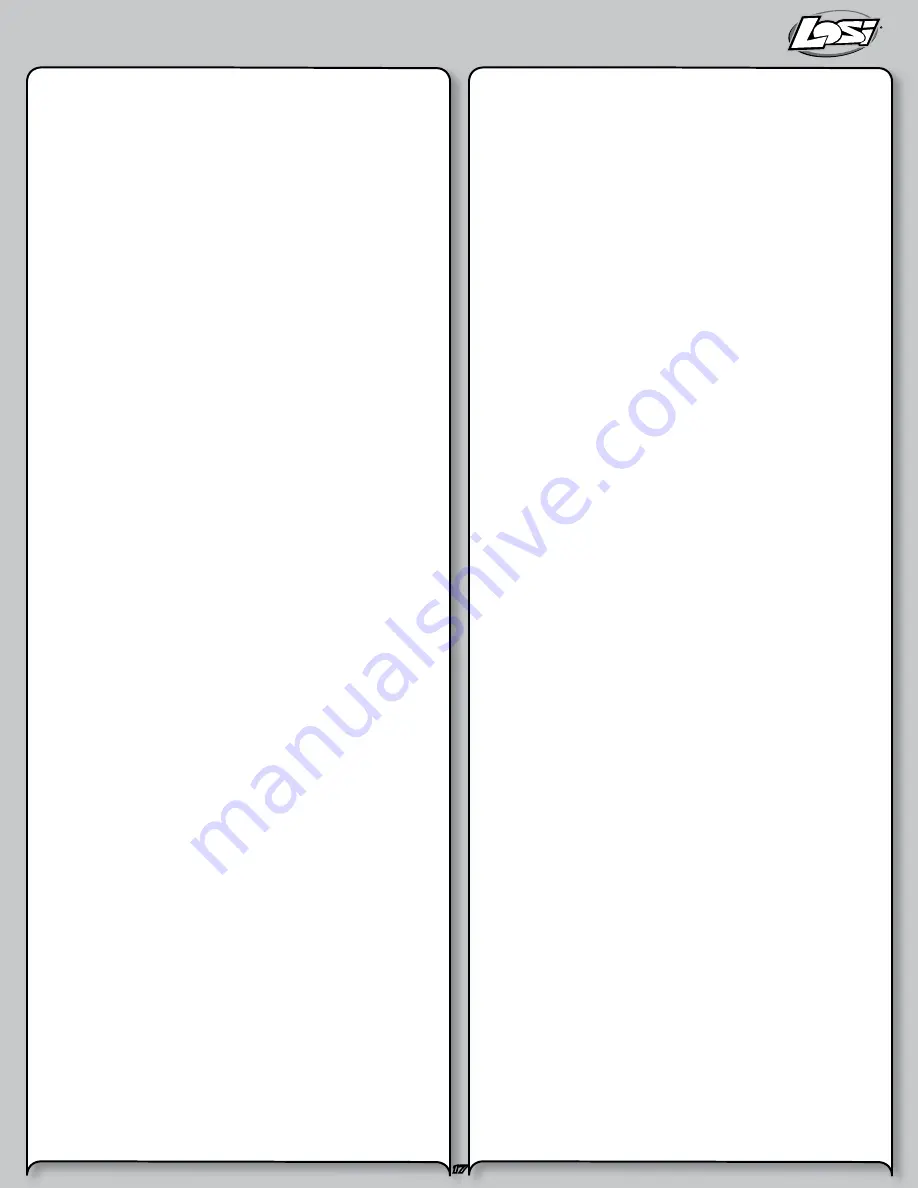
17
Tuning the Rear End of the Speed-NT
Shock Location
: Moving the shocks out on the arm will result
in less forward traction and let the Speed-NT make more of
an arc through the exit of the turn. In general, when changing
shock locations on the arm, it will be necessary to go down one
spring rate when moving out on the arm.
Static Camber
: Having the same definition as for the front end
and measured in the same fashion, rear camber can also be a
critical tuning feature. Testing has shown that running a small
amount of negative camber (.5-1 degree) is best. Increasing
negative rear camber (in the range of 1.5-3 degrees) will
increase stability and traction in corners, but decrease high-
speed stability. Decreasing rear camber (in the range of 0-1.5
degrees) will decrease stability and traction in corners, but will
increase high-speed stability.
Inboard Camber Location
: The Speed-NT has multiple rear
camber locations. Using a longer camber link will improve
stability and traction (grip). Using a shorter camber link will
increase steering while decreasing rear grip. Running the
camber link in the inside position on the shock tower will give
your Speed-NT more steering entering the turn as it will let
the Speed-NT set over the rear tire and give you more forward
traction exiting the turn. As you move the camber link towards
the outside of the Speed-NT, you will gain less initial steering,
however, you will gain more steering as the Speed-NT exits the
turn.
Outboard Camber Location
: Running the camber link in the
inside position on the hub will generate more rotation entering
a turn, but decrease steering on exit. Running the camber link
in the furthest outer position on the hub will generate more
stability entering a turn and increase steering on exit.
Toe-In
: Having the same definition as for the front end, the
toe-in can be adjusted on the Speed-NT with the rear hubs.
The stock toe-in is 3 degrees of inboard per side and 0 degrees
in the hub. Increasing rear toe-in will increase forward traction
and initial steering, but reduce straightaway speed. Decreasing
rear toe-in will decrease forward traction and “free-up” the
Speed-NT. Less toe-in can be used to gain top speed.
Ride Height
: This is the height of the chassis in relation to the
surface. It is an adjustment that affects the way your Speed-
NT jumps, turns and goes through bumps. To check the ride
height, drop one end (front or rear) of the Speed-NT from about
a 5-6 inch height onto a flat surface. Once the Speed-NT settles
into a position, check the height of that end of the Speed-NT
in relationship to the surface. To raise the ride height, lower the
shock adjuster nuts on the shock evenly on the end (front or
rear) of the Speed-NT that you are working on. To lower the ride
height, raise the shock adjuster nuts. Both left and right nuts
should be adjusted evenly.
You should start with the rear ride height where the Speed-NT
comes to a rest at a height where the dogbones are slightly
below level with the surface. The front ride height should be
set so that the bottom of the chassis is level with the surface.
Occasionally, you may want to raise the front ride height to get
a little quicker steering reaction but be careful as this can also
make the Speed-NT easily flip over. Every driver likes a little
different feel so you should try small ride height adjustments
to obtain the feel you like. This should be one of the last
adjustments after everything else has been dialed in (tuned).
Do not use ride height adjustment as a substitute for a change
in spring rate. If your Speed-NT needs a softer or firmer spring,
change the spring. Do not think that simply moving the shock
nuts will change the stiffness of the spring; it will not.
Summary of Contents for Speed NT
Page 23: ...23 Operating and Tuning Notes...







































